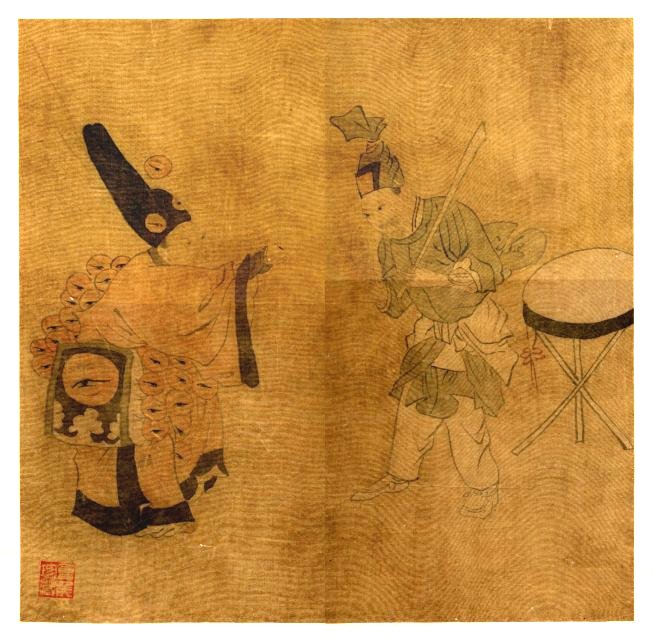
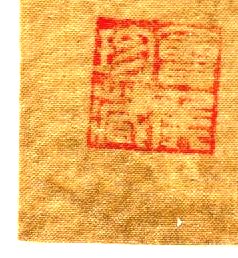
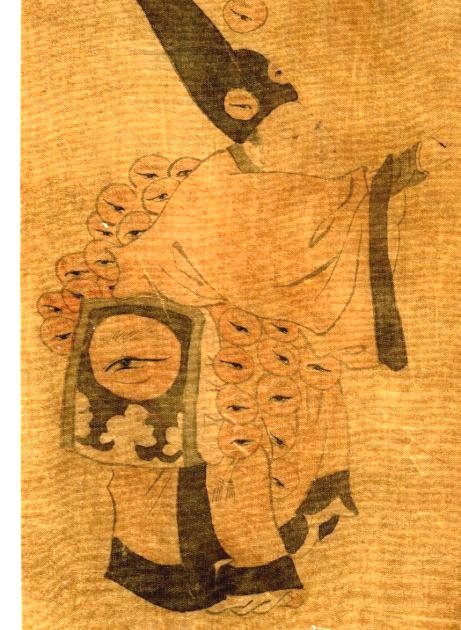
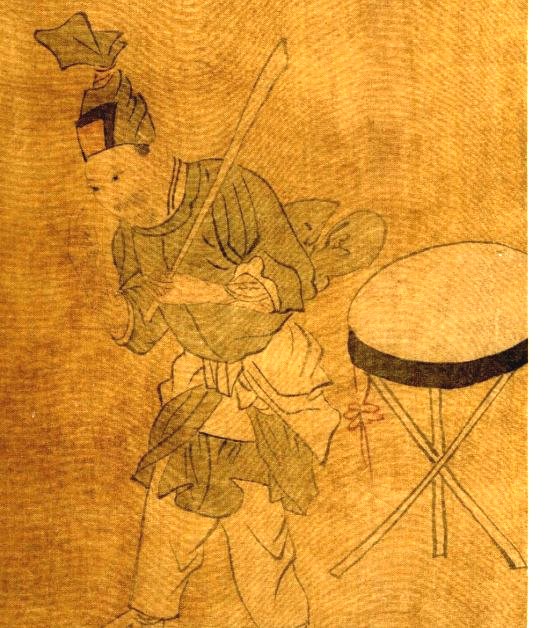
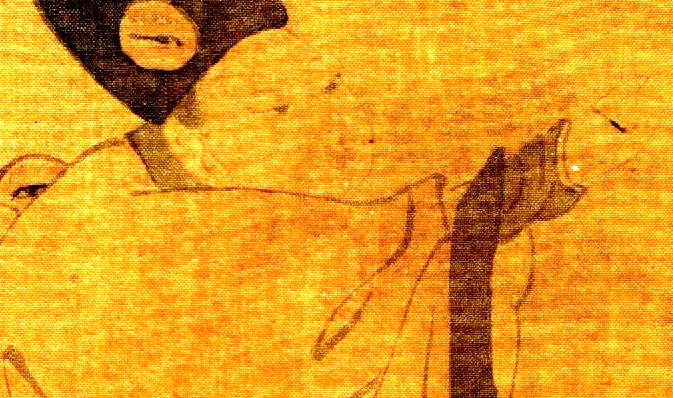
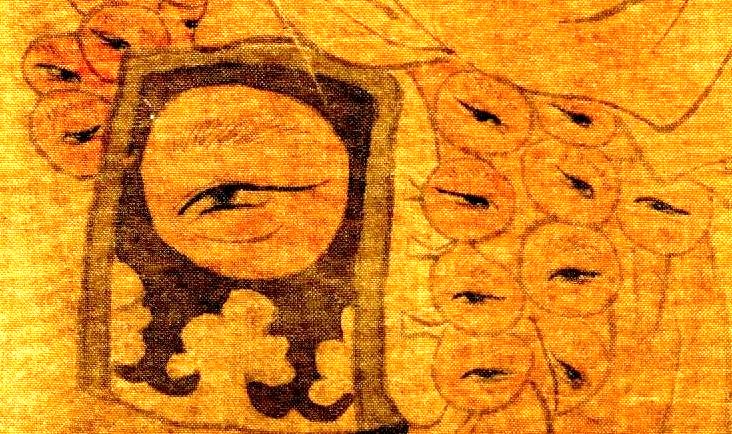
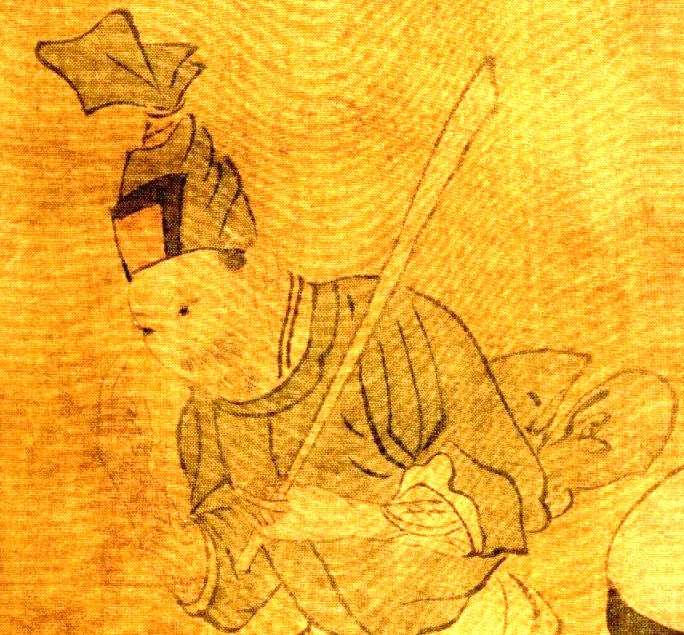







Advertising Painting for Southern Sung Dynasty (1127-1279) Zaju or Poetic Drama "Eyedrops"
Size 11 1/8" by 11 1/4"
南宋雜劇《眼藥酸》宣傳絹畫-- 原清收藏家耿嘉祚(17-18 世紀)藏品
This painting is unsigned but has a collector's seal belonging to the famous Qing Dynasty collector Geng Jia-zuo (actived in 17-early 18C). Zaju, poetic drama set to music, flourishing in the Yuan Dynasty (1271-1368), usually consisting of four acts called zhe(折), with one character having the singing role in each zhe. A similar copy of this painting is in the collection of Forbidden City Palace Museum in Beijing
此冊頁絹畫無款,但有一收藏印 “會
珍藏”
耿嘉祚-----清康熙間(公元十七至十八世紀人), 籍貫遼寧遼陽,字號會
, 漱六主人。
一幅類似絹畫現由北京故宮博物院庋藏。
====================================================================================================
In the ancient times of Chinese drawings, play theme's works actually appeared very scarce. Beijing Forbidden City Palace Museum has collected two Song dynasty drawing album pages which described two different Southern Song Dynasty zajus, namely “the eye medicine acid” and “the flower drum dance".
In the City of Jinan Nancheng of Northern Song Dynasty, commodity trades were very prosperous but profiteers were also very popular. For this reason some people created zajus or plays which attacked the sellers of fake and low-quality goods. For instance “the eye medicine acid” zaju ridiculed the merchant who sold the counterfeit goods, were welcome greatly by the public. The drawing depicted a scene of the zaju in which an actor points at the right eye with his hand, hinting of having eye disease, while another actor, carrying a cloth sack with a big eye drawing and surrounded by many eye drawings, is holding a bottle of eye medicine and showing it to the first actor. The two actors were wearing theatrical costumes. This drawing is vivid and appealing. According to the expert textual criticism, the purpose of the album drawing is to propagandize the zaju of“the eye medicine acid". It shows that advertising drawings were already well established and popular in the Southern Song era. This is one of the earliest recognized advertisement in the world which was almost two hundred years ahead of the West British first publisher William · triumphant Kersten the advertisement (ca 1473) which printed for the propaganda religion content's books.
=====================================================================================================
Southern Drama Zaju and Poetic Drama
Source: http://www.chinaculture.org/gb/en_artqa/2003-09/24/content_27274.htm
1. Zaju
During the Song Dynasty (960-1279), urban life became very active. In the flourishing night markets permanent arenas for performances, known as Wapeng, appeared and it was here that the Zaju drama developed.
Documents surviving from the Song Dynasty described how a Zaju drama had one scene and two or three parts. The first part, or Yanduan, was the prelude, the content of which was predictable; the second part was the main play, telling a story with intricate contents; and the third part, or Sanduan (the loose part), was a comical ending. A Zaju drama was usually performed by four to five players. The roles are Moni, Yingxi, Zhuangdan (for all female roles), and Gu (for officials).
Clashes between the Song and Kin Dynasties (960-1234) resulted in the introduction of Zaju to the area of north China under the rule of Kin. There they became known as Kin Yuanben or Kin Zaju. The drama of the Yuan Dynasty (1271-1368) is called Yuan Zaju.
No scripts of the Song or Kin Zaju have survived, but we do know the titles of 280 Zaju of the Song, and 690 Yuanben of the Kin. The Zaju dramas of the Song and Kin were still narrative songs and dances, plus dramatic performance, and they provided the groundwork for the birth of the Southern Drama and the Northern Zaju.
2. Southern Drama
During the Song Dynasty, Wenzhou was an important trading port in Zhejiang Province, south of China. It was in Wenzhou that a fully developed Chinese theater sprang to life, in the form of the Southern Drama.
Though comparatively unsophisticated, the Southern Drama had the basic characteristics of Chinese theater. First of all, it presented a complete story through singing, recitation, actions and other means. The narration of the story occupied an important position in the Southern Drama, and each drama had a beginning and an end. The length of these dramas varied from 20 programs to 50 or more, thus providing flexibility to reflect wide and complicated social issues.
The tunes of the Southern Drama came mainly from folk music, and the Ci poetry tonal patterns and rhyme schemes, as well as Zhugongdiao in various tempos. The songs could be solos, antiphonal or choral, and were interspersed with recitation, either monologues or dialogues. The combination of singing and recitation is characteristic of the Southern Drama. Bodily movements were called Ke and Jie, symbolic and exaggerated actions, in the Southern Drama.
In the Southern Drama there were five stereotyped characters: Sheng (male characters), Dan (female characters), Jing (or fujing, painted face), Mo (or fumo) and Chou (male clowns).
The representative works are: The Story of the Pipa, Top Scholar Zhang Xie, Zhu Wen and the Taiping Coins, The Story of the Hairpin, The Story of the White Rabbit, The Two Moon Prayer and The Story of killing the Dog, etc.
As compared with the performances of former ages, focusing on comic gestures and remarks, the Southern Drama marked great artistic progress, with impromptu comic gestures and remarks by the Chou, Jing and Mo being used for defusing tension.
3. Poetic Drama
During the Jiajing reign period (1522-1566) of the Ming Dynasty (1368-1644) the Southern Drama developed into another theatrical form -- Poetic Drama. Chinese theater entered its second golden era.
As Poetic Dramas extended from the Ming Dynasty into the Qing Dynasty (1644-1911), they carried on and improved the tradition of the Southern Drama. A script generally consisted of two parts and 40-50 programs. Playwrights paid particular attention to well-knit composition, and the use of comic gestures and remarks. The tunes of poetic dramas developed on the basis of that for the Southern Drama, Northern Drama as well as Yuan Zaju. One program might use more than one musical mode, depending on the demands of the plot. All the characters might sing.
Poetic Drama included numerous local tunes, of which Kunshanqiang, Yiyangqiang and Gaoqiang tunes were the most popular.
The Story of the Sword, The Story of Mingteng and Washing Gauze were the three most important poetic dramas created during the reign of Jiajing of the Ming Dynasty.
=========================================================================================
在我國古代繪畫中,戲劇題材的作品卻顯得十分稀少。北京故宮博物院庋藏無款宋人描繪南宋雜劇「眼藥酸」、「打花鼓」等冊頁兩幅。北宋濟南城裏商品雲集一片繁榮,不過奸商也很多,為此有人編了很多有關打假的雜劇,比如“眼藥酸廣告”來譏諷賣假貨的商人,一時大受百姓歡迎。
《眼藥酸》冊頁畫面內容是:兩個穿戲裝的演員,一人用手指著右眼,示意有眼病,另一人則背著布袋,袋上畫著許多眼睛,手拿一瓶眼藥酸,請有眼病的演員使用,這幅畫形象生動,情趣盎然。根據專家考據,《眼藥酸》冊頁是為了宣傳雜劇「眼藥酸」而畫的,由此可見純粹的廣告畫在南宋時期即已成熟,比西方公認最早的印刷廣告—1473年英國第一個出版商威廉·凱克斯頓為宣傳宗教內容的書籍而印製的廣告,還早了幾百年。
_____________________________________________________________________________________________
宋雜劇既不是一般戲劇的泛稱,也不同於元明所謂的雜劇。宋金雜劇院本的體製規律,基本上分為三部份、四段,即豔段、正雜劇(通名兩段)、散段(雜搬、雜扮、拔和、紐元子)。雜劇中,末泥為長,每四人或五人為一場。先做尋常熟事一段,名曰豔段;次做正雜劇,通名為兩段。」這樣的結構,或許是從大曲的三段來的。其中豔段為開場白,散段為送客曲。至於正雜劇(通名兩段),是雜劇的演出主體,兩段間沒有事件的邏輯關聯,只有動作的聯想。例如一段是演「項莊舞劍」的故事,一段演「公孫大娘舞劍」,項莊為秦末漢初人,公孫大娘是唐代人,舞劍的目的也不同,但同為舞劍,所以稱「通名兩段」。
宋金雜劇院本的腳色,共分為五大行當:末泥、引戲、副淨、副末、裝孤。這五大行當也被稱為「五花爨弄」。《都城紀勝•瓦舍眾伎》中說:「末泥色主張,引戲色分付,副淨色發喬,副末色打諢,又或添一人裝孤。」末泥即是如宋大曲中「竹竿子」的地位,引戲則是後世戲曲中的旦,副淨、副末乃是從參軍戲中參軍與蒼 鶻演化而來。裝孤為扮官員者,所以不一定都有。樂隊則稱為「把色」。
宋金雜劇院本的演出,多在勾欄瓦舍之中,但也有衝州撞府的「路岐人」。所謂「瓦舍」(又稱瓦市、瓦肆、瓦子,乃音近訛變),是聚集同性質的表演藝術團體的地方。根據《都城紀勝•瓦舍眾伎》的說法:「瓦者,野合易散之意也。不知起於何時,但在京師時,甚為士庶放蕩不羈之所,亦為子弟流連破壞之地。」勾欄為瓦舍中表演的場所。所謂「勾欄」,是指圍繞在三面觀眾的舞台口上,低矮的紅色欄杆。
金院本和宋雜劇分家,大概是在宋室南遷的時候。南宋紹興三十一年(西元1161)之前,宮廷中一直設有教坊。宋室南遷時,主要的雜劇演員,特別是北宋教坊中的演員,大多隨同南下,來到臨安。但是也有一部份的演員留在北方。當金在燕山〈即今北京〉建都時,它們就聚集在那裡,逐漸形成北方派的雜劇,即金院本。不過在這時,北方早就有了雜劇演員。據《宋史•孔道輔傳》:「道輔奉使契丹,契丹宴使者,優人以文宣王為戲,道輔絕然徑出。」但這不能據以否定金院本對宋雜劇的繼承關係。如果拿《院本名目》來和《官本雜劇段數》做一比較,就可看出雜劇在藝術形式上的變化軌跡。
首先是綴以大曲、法曲、詞調等名目的節目已大大減少。《官目》中這一部份佔百分之五十以上,而《院目》中的劇名多半不綴曲名。是否這些不綴曲名的都不唱呢?也不竟然。如「題目院本」原是由「唱題目」發展出來的,很可能跟「和曲院本」一樣是以唱為主。而其中只有《楊柳枝》一目是以詞調為名。又如「上皇院本」也只有《春從天上來》一目為詞調之名。那麼其餘的又是用什麼曲調來唱的呢?對此目前雖無法肯定,但其中當有用當時流行於燕京和冀州一代的曲調來唱。這就開了後世北曲的端倪。
另外,前面的「豔段」形式豐富了。除了仍有爨以外,又出現了「沖撞引首」、「拴搐豔段」等形式,把正雜劇的「通名」,拿出來在「豔段」中加以詮釋、演繹。這些形式的演化產生,說明了一種趨勢,就是要使得兩段正雜劇的演出更能統一,有更多的內在連系。
最後,雜劇在宋室南遷前後,與南方鄉間的歌謠相結合,產生了南戲;幾乎同時,金院本則通過「院么」與「么末」,在元滅金之前,於中國北方形成了北曲雜劇。這一南一北的光輝,造就了中國最早的大戲,也開創了戲曲史上的第一個黃金時代。